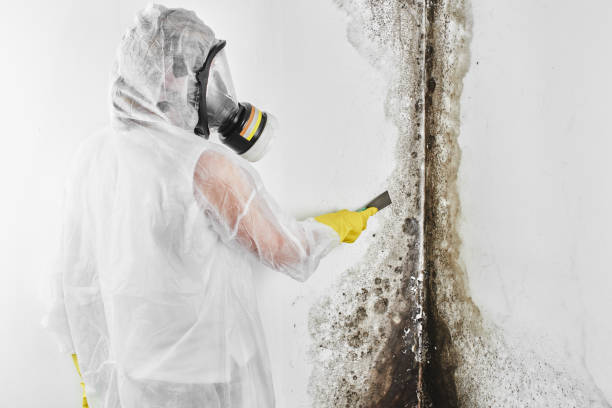Many natural home remedies help against mold in the apartment and in the basement. This is how you fight and drive away mold effectively and prevent new mold from forming.
Once the mold has “moved in”, you first have to find the cause in order to combat the mold in the long term. We will explain how you can get to the bottom of the causes, remove the mold and prevent new growth. Once the mold has been removed, the moldy smell that comes with it, which is particularly common in the basement, usually disappears.
Causes of mold in the apartment and basement
Where there is mold, there is also moisture! Mold is not just a “beauty problem”. It’s about health and much more: Mold threatens due to its cause – moisture! – also the substance and the value of your property!
Everyone actively and passively produces humidity: Whether showering, cooking or simply breathing: we constantly produce “humidity”. And that’s not exactly little. When we shower or cook, tend houseplants, or do laundry, the air humidity regularly increases. And when we sweat, more is added.

1) Vinegar against mold
Vinegar has a low pH. Most types of mold do not tolerate such an environment. Therefore, fighting mold with this old household remedy works quite well in smaller infested areas. In addition, vinegar has no toxic substances. Application: Drizzle plenty of vinegar onto a cloth and rub it vigorously into the affected area. Then wipe the entire surface with a damp cloth. Destroy all rags immediately after use!
Vinegar should not be used under any circumstances if limescale is involved: Stiftung Warentest has tested a number of home remedies against mold infestation in detail. Vinegar performed very well here, but with one caveat: Vinegar is completely unsuitable as a remedy against mold growth on limestone walls.
Why? The acetic acid forms a compound with lime, which is particularly popular with mold as a breeding ground. Treating a moldy limestone wall with vinegar therefore only shows short-term success. Within a few days, however, the mold blooms again and reaches an even more intensive infestation than before. Vinegar could only do well in the detailed test by the Stiftung Warentest if the mold was on a firm and level surface. Please also note useful tips for cleaning awnings and removing mold.
2) Hydrogen peroxide against mold
Known as a hair bleaching agent, hydrogen peroxide kills mold. When using it, the substrate must be absolutely dry. You can test the contaminated area for dryness using blotting paper BEFORE use. If there are damp stains on the blotting paper and if it was previously pressed firmly onto the mold area, you should first dry the surface thoroughly with a hairdryer or radiant heater before use.
Once everything is dry, you should close the doors and windows in the affected room. Then you spread the affected area and the surrounding area generously with hydrogen peroxide. After about an hour, the area can be wiped off with a damp cloth.
3) Alcohol and methylated spirits as mold killers
On the one hand, alcohol has a disinfecting effect and, on the other hand, it removes the vital water from the mold. This is how the molds dry out. The alcohol must have a concentration of at least 70%. You can also use medicinal alcohol. Isopropanol – IPA for short – is a good choice, for example.
When choosing this means of destroying mold, care should be taken to ensure that the alcohol penetrates deep into the subsoil, because that is where the branched roots of the mold spores are located. The disadvantage is that alcohol evaporates very quickly.
Therefore, treatments with alcohol must be repeated several times in order to achieve satisfactory results. In a test by Stiftung Warentest, alcohol achieved very good results as a mold killer based on repeated applications. The use of methylated spirits as a home remedy against mold corresponds roughly to the use of alcohol.
Here, too, it should be noted that the spores are invisible, and only visibly affected areas should be treated yourself. It is also important to find the cause and eliminate it permanently. If in doubt, it is best to consult a specialist!
Be careful when fighting mold
Smaller areas affected by mold can sometimes be removed first with home remedies. Nevertheless, there are a few things to consider when using the “do-it-yourself method” of mold removal in order to avoid health consequences!
Mold has spores that are invisible and spread through the air. This is how they get into human respiratory organs, which can cause allergies and other diseases. In addition, inhaling mold spores weakens the immune system.

How can you avoid mold?
Mold is often caused by damp walls or excessive humidity. Today’s structural engineering options for insulating and sealing buildings ensure that a lot of energy can be saved when heating. Unfortunately, there is the negative side effect that the houses tend to be less well ventilated, which means that even small weak points in the thermal insulation can promote mold growth. The kitchen, bathroom, and bedroom are areas that are particularly at risk here since their use results in higher room humidity with less heating at the same time.
Let the water vapor out again quickly
Moisture in living spaces is mainly generated by people. With four people in a household, for example, around twelve liters of moisture in the form of water vapor can occur every day. Plenty of water vapor is produced when showering, washing, and cooking. He should leave the room as soon as possible. It is also helpful if bathrooms are permanently heated.
